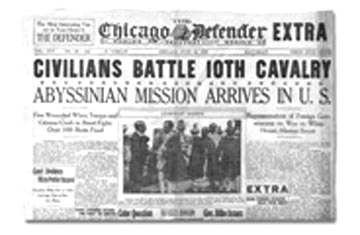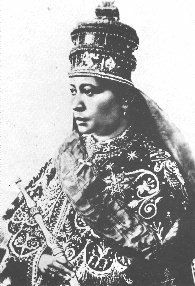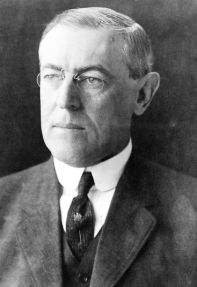
Above: A headline by the Chicago Defender announcing the
arrival of the first Abyssinian diplomatic delegation to the United
States on July 11, 1919.
By Liben Eabisa
New York (Tadias) – The arrival of the first Ethiopian diplomatic delegation to the United States on July 11, 1919 made headlines in Chicago, where journalists eagerly awaited their opportunity to meet and interview the delegation.
At the time Woodrow Wilson was serving as the 28th President of the United States. In Ethiopia, Empress Zawditu, the eldest daughter of Emperor Menelik, was the reigning monarch.
Dejasmatch Nadew, Empress Zawdituís nephew and Commander of the Imperial Army, along with Ato Belaten-ghetta Hiruy Wolde Sellassie, Mayor of Addis Ababa, Kentiba Gebru, Mayor of Gonder, and Ato Sinkas, Dejamatch Nadew’s secretary, comprised the first official Ethiopian delegation to the United States in the summer of 1919.
The main purpose of their trip was to renew the 1904 Treaty of Amity (Friendship) between the United States and Ethiopia (brokered when President Theodore Roosevelt authorized 37-year-old Robert P. Skinner to negotiate a commercial treaty with Emperor Menelik).
The treaty had expired in 1917. This four-man delegation to the United States became known as the Abyssinian mission.
The distinguished delegation headed to the White House in Washington D.C. after staying at the elegant Waldorf-Astoria in Chicago.


Above: Left, Empress Zawditu (In office: 1916 to 1930),
Right, President Woodrow Wilson (In office: March 4, 1913 – March 4, 1921).
The group visited the U.S. at a time when blacks were by law second-class citizens and the most common crime against American blacks was lynching. Before leaving Chicago, a reporter for the Chicago Defender, an African American newspaper, asked the delegation what they thought about lynching in the U.S. The representatives responded “[We] dislike brutality… lynching of any nature, and other outrages heaped upon your people.”
African-Americans were inspired to see a proud African delegation being treated with so much respect by U.S. officials. Newspapers reported that in honor of the delegation’s visit “the flag of Abyssinia, which is of green, yellow, and red horizontal stripes, flew over the national capitol.”
The Chicago Defender reported that the delegation expressed their support for the struggle of American blacks and gave them words of encouragement. A member of the press had inquired if the group had advice to African-Americans. Ato Hiruy Wolde Sellassie, who spoke fluent English, replied: “Fight on. Don’t Stop.”
The Ethiopian presence at the Waldorf Astoria, dressed in their traditional white robe and pant attire attracted large attention.
Upon arriving in Washington D.C. they took up residence at Hotel Lafayette and awaited their formal presentation at the White House.
“It perhaps is of much interest to know that the Abyssinian religion is the oldest Christian religion in the world”, Captain Morris, the delegation’s chaperon, told reporters. “The queen of Sheba, who visited Solomon was once their queen, and the present ruler is descended from the queen of Sheba.”
The Abyssinian Mission enjoyed an overall warm welcome and before returning to Ethiopia, they toured the cities of New York and San Francisco. They also visited an Irish Catholic cathedral, a Jewish synagogue, the Metropolitan Baptist Church in Harlem, and Yellowstone National Park.
—-
About the Author:
Liben Eabisa is the Founder & Publisher of Tadias Magazine. He is also the publisher of the book: Abyssinia of Today – Reissue of Robert P. Skinner’s memoir, a narrative of the first American diplomatic mission to black Africa. Liben Eabisa lives in New York City.

























